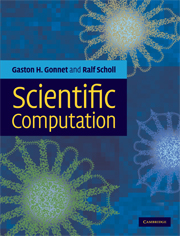Book contents
- Frontmatter
- Contents
- Preface
- List of abbreviations
- 1 Determination of the accurate location of an aircraft
- 2 When to replace equipment
- 3 Secondary structure prediction using least squares and singular value decomposition
- 4 Secondary structure prediction using least squares and best basis
- 5 Secondary structure prediction with learning methods (nearest neighbors)
- 6 Secondary structure prediction with linear programming (LP)
- 7 Stock market prediction
- 8 Phylogenetic tree construction
- Appendix A Methods for function minimization
- Appendix B Online resources
- Index
3 - Secondary structure prediction using least squares and singular value decomposition
Published online by Cambridge University Press: 17 February 2011
- Frontmatter
- Contents
- Preface
- List of abbreviations
- 1 Determination of the accurate location of an aircraft
- 2 When to replace equipment
- 3 Secondary structure prediction using least squares and singular value decomposition
- 4 Secondary structure prediction using least squares and best basis
- 5 Secondary structure prediction with learning methods (nearest neighbors)
- 6 Secondary structure prediction with linear programming (LP)
- 7 Stock market prediction
- 8 Phylogenetic tree construction
- Appendix A Methods for function minimization
- Appendix B Online resources
- Index
Summary
Topics
Secondary structure prediction (SSP)
Modelling
Least squares (LS)
Singular value decomposition (SVD)
Eigenvalue decomposition (EVD)
Secondary structure prediction in proteins is an essential problem of molecular biology.
See the web page of the European Molecular Biological Laboratory Heidelberg and the ExPASy web pages to get an impression of the multitude of tools used for SSP. We begin with a short summary of the biochemical facts.
Extremely brief introduction to protein biochemistry
BASIC Proteins are basically chain molecules built up from sequences of amino acids (AAs). There are 20 different amino acids, as listed in Table 3.1. The chemical structures of the amino acids and further detailed information can be found, for example, in the Amino Acid Repository of the Jena Library of Biological Macromolecules or at the FU Berlin.
Protein structure can be described at three levels.
The primary structure is the sequence of amino acids in the chain, i.e. a one-dimensional structure. The primary structures of millions of proteins are known today, many of them for several species. They can be found, among other places, in the SwissProt database.
The secondary structure is the result of the folding of parts of the AA-chain. The two most important secondary structures are the α-helix and the β-sheet. There exist other secondary structures which are of lesser importance such as turns, 3-10 helices, etc.
[…]
- Type
- Chapter
- Information
- Scientific Computation , pp. 25 - 48Publisher: Cambridge University PressPrint publication year: 2009

